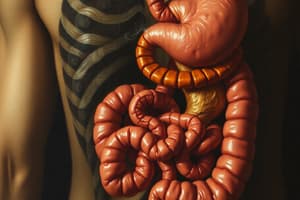Podcast
Questions and Answers
What is the primary function of pancreatic lipase in small intestine?
What is the primary function of pancreatic lipase in small intestine?
- Breaking down proteins into amino acids
- Regulating pH levels in the small intestine
- Hydrolyzing fats into monoglycerides and fatty acids (correct)
- Absorbing carbohydrates into the bloodstream
What is the primary site of lipid absorption in the small intestine?
What is the primary site of lipid absorption in the small intestine?
- Thoracic duct
- Hepatic portal vein
- Hepatic artery
- Lacteals of the villi (correct)
What is the function of carboxypeptidase in protein digestion?
What is the function of carboxypeptidase in protein digestion?
- Removing amino acids from the carboxyl end of peptides (correct)
- Hydrolyzing peptides into amino acids
- Inhibiting digestive enzymes
- Breaking down carbohydrates into simple sugars
Where are amino acids absorbed into the bloodstream?
Where are amino acids absorbed into the bloodstream?
What is the role of bile salts in lipid digestion?
What is the role of bile salts in lipid digestion?
What is the fate of absorbed lipids in the lymphatic system?
What is the fate of absorbed lipids in the lymphatic system?
What is the primary function of aminopeptidase in protein digestion?
What is the primary function of aminopeptidase in protein digestion?
What is the role of the liver in the digestion and absorption of nutrients?
What is the role of the liver in the digestion and absorption of nutrients?
What is the primary site of protein digestion in the small intestine?
What is the primary site of protein digestion in the small intestine?
What is the function of the hepatic portal vein in the digestive system?
What is the function of the hepatic portal vein in the digestive system?
Flashcards are hidden until you start studying
Study Notes
Digestive System
- Pepsin is an enzyme that breaks down large proteins into amino acids.
- Food is further broken down into a thin liquid called chyme.
Accessory Organs
- The pancreas secretes both digestive enzymes (exocrine) and hormones (endocrine).
- Pancreatic juice digests all major nutrient types.
- The liver produces bile, which is stored in the gallbladder until needed.
- Bile breaks up fats, acting like detergents, and contains colors from old red blood cells.
Bile
- Bile is a bitter, greenish-yellow alkaline fluid stored in the gallbladder between meals.
- Upon eating, bile is discharged into the duodenum where it aids digestion.
- Bile emulsifies lipids (physically breaks apart fats).
Pancreas
- Digestive enzymes produced by the pancreas include:
- Trypsin and chymotrypsin, which digest proteins.
- Amylase, which digests starch.
- Buffers produced by the pancreas neutralize acid from the stomach.
Liver
- The liver produces bile, which breaks up fats.
- The liver also collects iron from old red blood cells, making feces brown.
Small Intestine
- Most chemical digestion takes place in the small intestine.
- Simple sugars and proteins are absorbed into the inner lining of the small intestine.
- Fatty acids and glycerol go to the lymphatic system.
- The small intestine is lined with villi, which increase surface area for absorption.
Absorption
- Amino acids enter the capillaries of the villi and are transported to the liver via the hepatic portal vein.
- Absorption of lipids occurs primarily into the lacteals of the villi and is transported in the lymph to the systemic circulation via the thoracic duct and then to the liver via the hepatic artery.
Studying That Suits You
Use AI to generate personalized quizzes and flashcards to suit your learning preferences.




